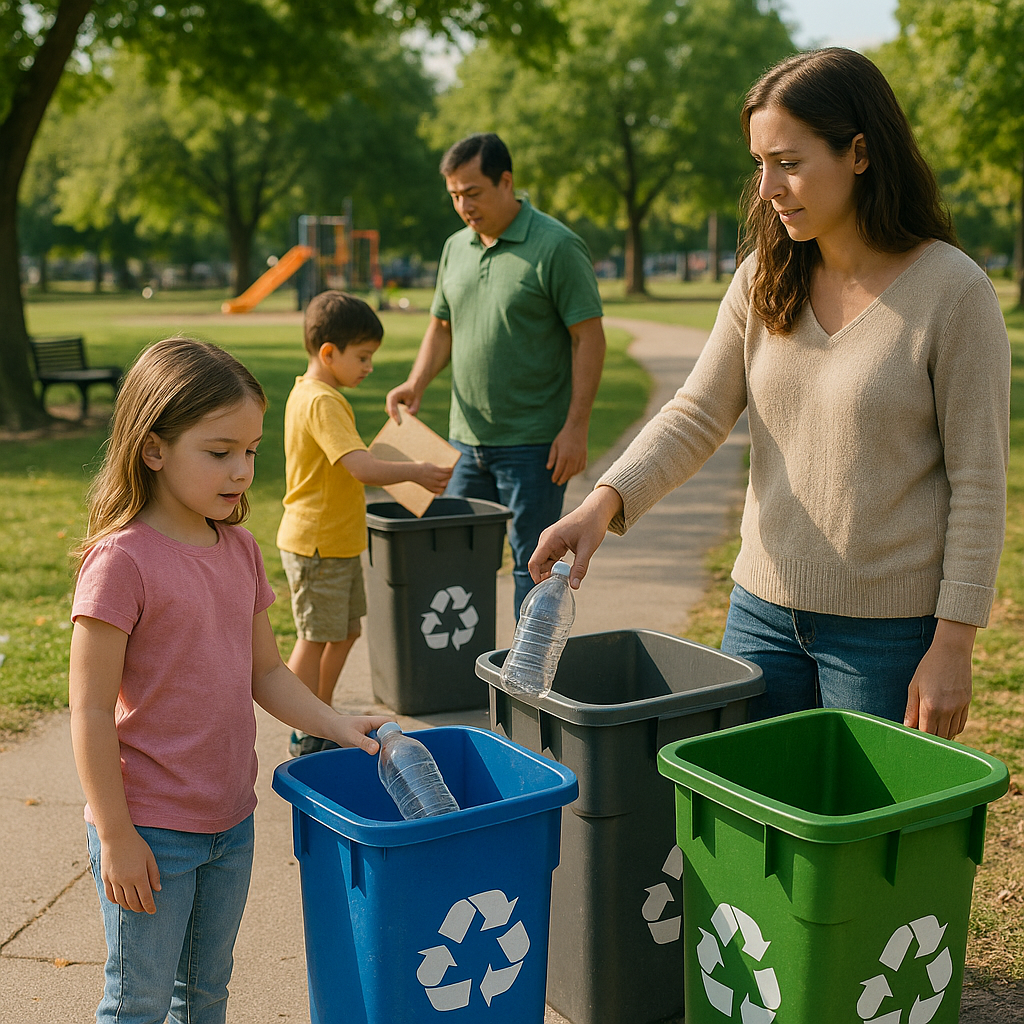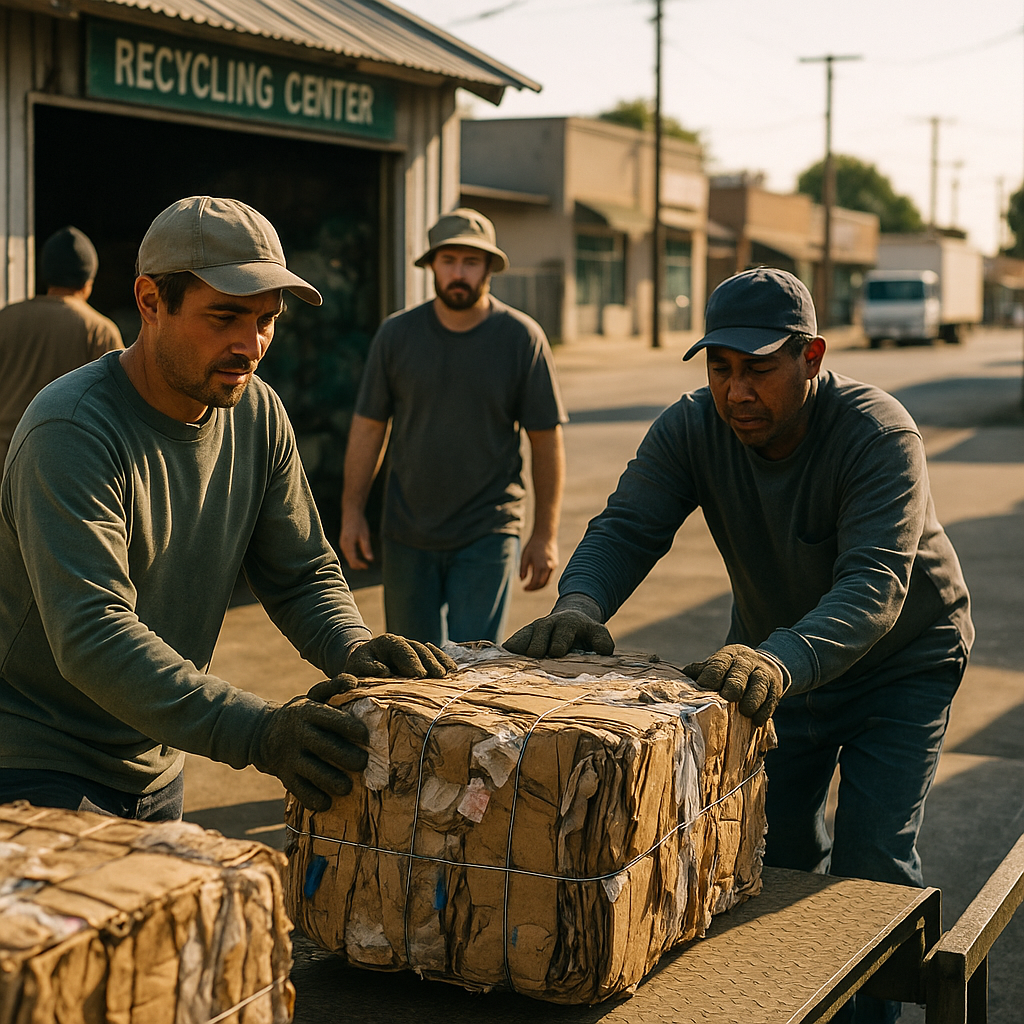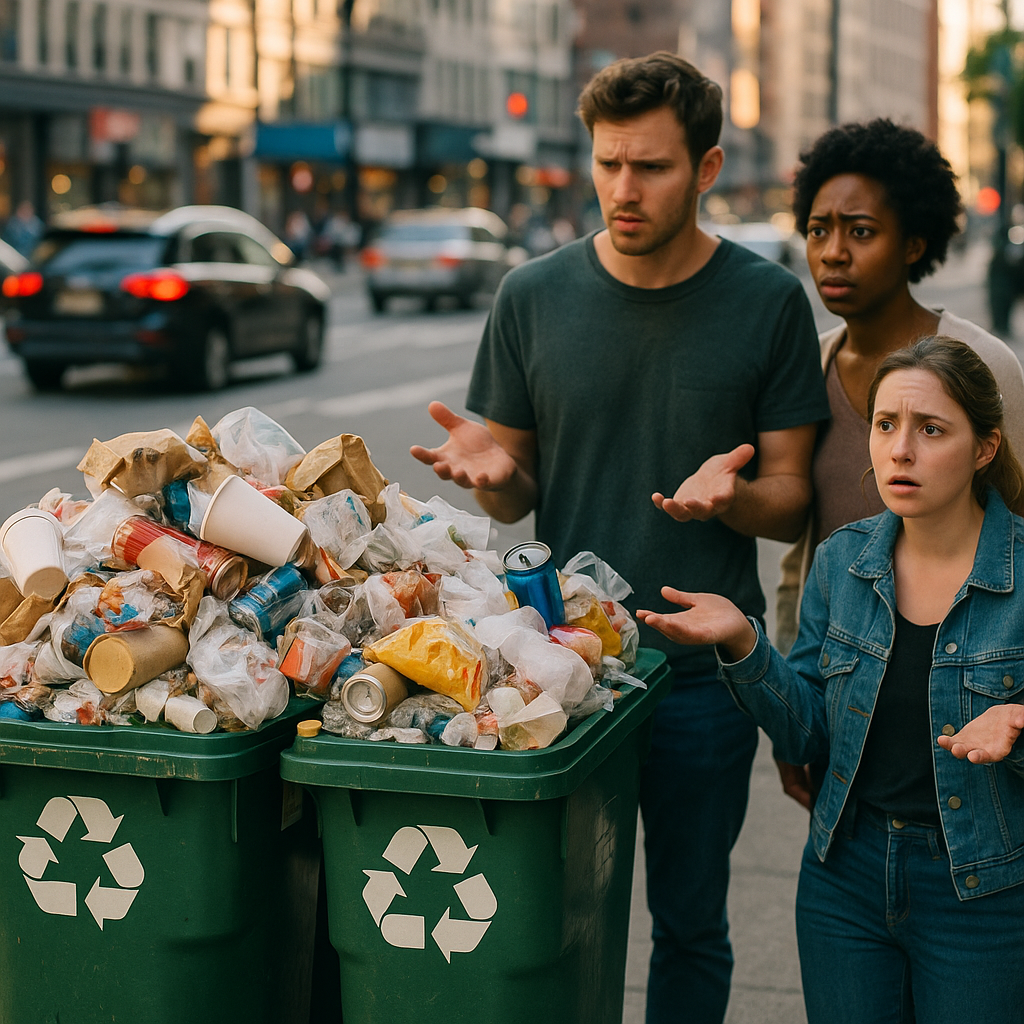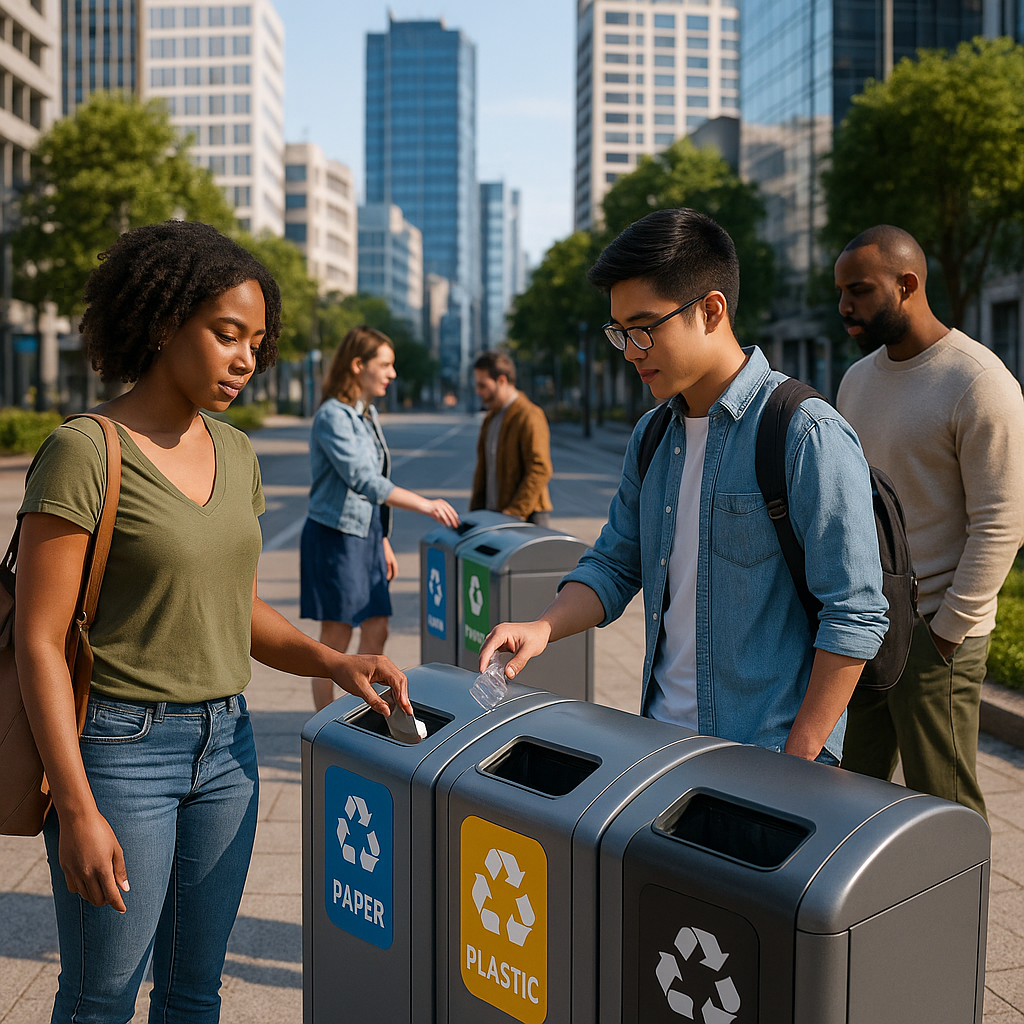5901 Botham Jean Blvd, Dallas, TX 75215
How Does Public Recycling Work? A Quick Overview
August 16, 2025Every day, billions of items are discarded across communities worldwide. Public recycling transforms potential waste into valuable resources through a structured system that collects, sorts, and processes recyclable materials for manufacturing new products. This process is crucial for environmental protection and resource conservation.
Public recycling functions as a reverse supply chain, beginning with collection bins in neighborhoods, businesses, and public spaces. The system diverts materials like plastic bottles, paper, and aluminum cans from landfills. By redirecting these materials, recycling helps conserve natural resources and reduce greenhouse gas emissions.
The recycling journey unfolds in three main steps. First, materials are collected and processed at recovery facilities where they are sorted by type. Next, these sorted materials become inputs for manufacturing new products. Finally, when consumers purchase these recycled products, they complete the cycle. This circular approach transforms what was once considered trash into valuable commodities.
What Are the Key Steps in the Public Recycling Process?

The public recycling process transforms discarded materials into reusable resources through a reverse supply chain consisting of three essential steps, promoting a circular economy.
Step 1: Collection
The recycling journey begins with gathering materials from various sources. Collection methods vary based on location and infrastructure:
Curbside pickup programs allow residents to place recyclables in designated bins for scheduled collection, typically accepting paper, cardboard, plastics, glass, and metal cans. Businesses often use similar arrangements with private haulers or municipal services.
Drop-off centers provide locations for people to bring sorted recyclables, particularly valuable for items not accepted at curbside, like electronics, batteries, or certain plastics. Deposit programs encourage returning items like beverage containers by offering a small refund per item.
Step 2: Processing and Sorting
Collected recyclables are transported to Materials Recovery Facilities (MRFs), where they are separated, cleaned, and prepared for remanufacturing:
In MRFs, materials undergo mechanical and manual sorting. Technology, including conveyor systems, screens, magnets for steel, eddy currents for aluminum, and optical scanners for plastics, assists in separating materials. Workers perform quality control to remove contaminants that machines may miss.
Sorted materials are cleaned of food residue, labels, and other contaminants that could affect quality. They are then compressed into dense bales, typically weighing about one ton, for storage and transport to the next recycling stage.
| Collection Method | Description | Advantages | Disadvantages |
| Curbside Pickup | Recyclables are collected directly from homes using designated bins. | Convenient for residents; increases participation rates. | Higher operational costs; risk of contamination high in single-stream. |
| Drop-off Centers | Individuals bring recyclables to a central location. | Cost-effective for municipalities; lower contamination rates. | Requires consumer effort; dependent on participation. |
| Deposit/Refund Programs | Refund for return of specific recyclable items like bottles. | Encourages recycling via financial incentives; lowers litter. | Limited to certain materials; requires administrative oversight. |
Step 3: Manufacturing and Reintegration
This final stage transforms processed recyclables into new products, completing the recycling loop:
Materials follow specific remanufacturing paths. Paper is pulped into new paper products. Plastics are melted into pellets for new plastic products. Metals are melted and reshaped, and glass is turned into cullet for new containers.
Recycled materials enter the conventional manufacturing supply chain as substitutes for virgin raw materials. As manufacturers use recycled content, they reduce the need to extract new resources. Consumers who purchase these products drive demand for recyclable materials, supporting the circular economy.
Challenges in the Recycling Process
While straightforward in concept, several challenges can affect recycling efficiency. Contamination, from non-recyclable items or dirty materials, increases processing costs and lowers the quality of recycled materials.
Market fluctuations affect the system, as recycled materials’ value changes with supply, demand, and global economic conditions. Lower prices can financially strain recycling programs. Moreover, some materials are difficult to recycle due to their composition or available technology.
Despite these challenges, recycling is crucial for sustainable waste management, conserving resources, reducing energy use, and cutting pollution while creating jobs and economic opportunities in the recycling industry.
What Are the Environmental Benefits of Public Recycling?

Public recycling programs provide substantial environmental benefits that extend well beyond diverting waste from landfills. When communities emphasize recycling initiatives, they contribute to significant environmental improvements locally and globally.
Reduction in Greenhouse Gas Emissions
A major environmental advantage of public recycling is its ability to reduce greenhouse gas emissions. Manufacturing products from recycled materials usually requires significantly less energy than using raw materials, resulting in fewer carbon emissions.
The EPA reports that recycling and composting municipal solid waste saved over 193 million metric tons of carbon dioxide equivalent in 2018. This is akin to removing the emissions from over 41 million passenger vehicles for an entire year. Even recycling a single ton of paper can cut greenhouse gas emissions by approximately one metric ton of carbon equivalent.
Aluminum recycling offers particularly significant benefits. Producing aluminum from recycled materials uses 95% less energy than manufacturing it from bauxite ore, greatly reducing carbon emissions. Each ton of recycled aluminum prevents about 9 tons of CO2 emissions.
Conservation of Natural Resources
Recycling is crucial for preserving our planet’s finite natural resources. By reusing existing materials, we reduce the need for extracting, refining, and processing raw materials from the earth.
Paper recycling helps protect forest resources. Without recycling, wood harvesting would need to increase by 80% to meet paper consumption demands. Recyclable programs can limit that increase to just 20%, aiding in the maintenance of forest ecosystems vital for biodiversity and carbon sequestration.
Metal recycling significantly reduces the environmental impact of mining operations. Using scrap steel instead of virgin ore creates 97% less mining waste and requires 40% less water. Additionally, metals like aluminum and glass can be recycled indefinitely without quality loss, fostering a sustainable cycle of resource use.
Landfill Reduction and Pollution Prevention
Public recycling programs significantly decrease the amount of waste sent to landfills. Research shows that approximately 72% of all landfill waste could be recycled or composted.
This reduction in landfill use yields multiple environmental benefits. Landfills produce methane, a greenhouse gas 25 times more potent than carbon dioxide, as organic waste decomposes anaerobically. Diverting recyclable materials helps minimize these harmful emissions.
Beyond gas emissions, landfills can lead to soil and water contamination through leachate – the liquid that results from waste decomposition and mixing with rainwater. This toxic substance can infiltrate groundwater and nearby ecosystems. Recycling prevents this pollution by keeping potentially harmful materials out of landfills.
Energy Conservation
The energy savings from recycling are considerable and generate cascading environmental benefits. Recycling aluminum saves about 95% of the energy needed to produce new aluminum. Likewise, recycled steel saves 60% in production energy, recycled newspaper 40%, recycled plastics 70%, and recycled glass 40%.
These energy savings directly lead to reduced air and water pollution. By using recycled paper, manufacturers reduce their air pollution by 73% and water pollution by 35%. The cumulative effect is significant – the energy saved by recycling bottles and cans in California alone could power 522,000 homes for a year.
The energy lost from discarding recyclable materials like aluminum cans and newspapers yearly equals the output of 15 power plants, highlighting the collective impact of individual recycling decisions on our energy resources.
| Material | Energy Savings (%) | Energy Saved per Tonne (kWh) |
|---|---|---|
| Aluminium | 95% | 14,000 |
| Steel | 60% | 1,400 |
| Plastic (PET) | 76% | 7,200 |
| Paper | 60% | 4,100 |
Protection of Local Ecosystems
Public recycling initiatives protect local habitats and ecosystems that would be disrupted by raw material extraction. Mining operations for metals, petroleum drilling for plastics, and timber harvesting for paper all affect natural environments.
Effective recycling reduces the need for new extraction sites, preserving land that serves as wildlife habitat. This represents essential contributions to maintaining biodiversity and ecosystem services like clean water, air filtration, and flood control.
Additionally, recycling helps prevent pollution that would otherwise harm local ecosystems. Manufacturing from raw materials often generates significant water pollution. For instance, recycling one ton of paper saves approximately 7,000 gallons of water and eliminates manufacturing wastes that would typically enter water systems.
The environmental benefits of public recycling grow with community participation rates. Each recycled item contributes to energy savings, resource conservation, pollution reduction, and ecosystem protection. By supporting robust recycling programs, communities make meaningful contributions to environmental sustainability on both a local and global scale.
How Does Public Recycling Impact Local Economies?

Public recycling programs serve as strong economic drivers for local communities. Beyond environmental benefits, these initiatives create substantial economic opportunities through job creation, revenue generation, and cost reduction. Communities investing in comprehensive recycling infrastructure often see economic growth and enhanced stability.
Job Creation Across Multiple Sectors
Recycling programs generate significantly more employment than traditional waste disposal methods. For every 1,000 tons of material recycled, approximately 1.57 jobs are created, alongside $76,000 in wages and $14,101 in tax revenue. In contrast, landfilling the same material creates just 0.1 jobs.
These opportunities span various skills and sectors: collection drivers, sorting facility workers, processing technicians, and sales representatives play vital roles in recycling. In manufacturing, recycled materials support jobs in paper mills, metal smelters, and plastic manufacturing facilities, transforming these materials into new products.
The South Carolina recycling industry’s potential is evident. Between 2006 and 2014, its economic impact nearly doubled, with a 44% increase in job growth. Today, recycling in South Carolina accounts for $13 billion in economic impact, contributes $329 million in taxes, and provides over 54,000 jobs.
Quality Employment Opportunities
Many recycling industry positions offer competitive wages. Workers in specialized sectors often earn above the national average, boosting local purchasing power and community stability. According to industry research, jobs in recycling offer average wages and benefits exceeding $70,000, forming a solid middle-class foundation.
Blue Star Recyclers in Colorado illustrates how recycling can create meaningful employment while addressing social needs. This enterprise employs individuals with autism and other developmental disabilities through electronics recycling, providing over 40 local jobs and contributing $4 million in new revenues while saving taxpayers $1.5 million.
Revenue Generation for Municipalities
Communities gain financial benefits from recycling programs by selling processed materials. Favorable market conditions allow municipalities to generate significant revenue, creating a circular flow of materials and money locally.
Recyclable materials currently in landfills are valued at over $11 billion annually in the United States. Effective recycling programs redirect this value back to local economies.
Florence, Alabama offers a compelling example of successful municipal recycling economics. Its program, established in 1988, avoided over $1 million in landfill fees from 2009 to 2019 while generating revenue from material sales to nearby manufacturers. The program supports regional jobs, including 1,200 employees at the aluminum recycling center processing Florence’s materials.
Reducing Waste Management Costs
Recycling offers cost avoidance advantages. Communities with effective programs reduce expenses related to landfill management and waste disposal. These savings grow as landfill tipping fees increase nationwide.
In Kinston, North Carolina, an improved recycling program saved the city $100,000 in fuel and labor costs. Transitioning from small 18-gallon containers to 95-gallon wheeled carts and implementing automated collection created savings while increasing resident participation.
The multiplier effect of recycling operations amplifies economic benefits. Equipment manufacturers, technology providers, and transportation companies benefit from robust recycling infrastructure, spreading advantages throughout the supply chain.
Stimulating Broader Economic Growth
Recycling stimulates broader economic growth by creating demand for supporting services. As recycling rates increase, local businesses emerge to meet the sector’s needs. Equipment manufacturers, technology providers, and transportation companies benefit from a strong recycling infrastructure.
Robust recycling programs also foster business ecosystems where one company’s waste becomes another’s resource. The Catawba County EcoComplex in North Carolina demonstrates this integrated facility generating power from landfill methane and housing businesses using each other’s by-products, creating a closed-loop system that maximizes resource efficiency while minimizing environmental impact.
Local economies gain resilience through recycling and remanufacturing, creating economic diversity that helps weather downturns. Combined with sustainability initiatives, recycling programs contribute to a stable economic foundation.
Communities prioritizing recycling signal their commitment to higher quality of life, making them attractive places to live, work, and do business. Attracting sustainable industries and environmentally conscious residents further strengthens the local economy.
What Challenges Does Public Recycling Face?

Public recycling programs face multiple challenges that hinder their effectiveness. These issues affect the entire recycling ecosystem, from collection to processing and reselling materials.
Contamination: A Major Barrier
Contamination happens when non-recyclable items end up in recycling bins, reducing the quality and value of true recyclables. In the United States, recycling facilities spend over $300 million annually on extra labor, processing, equipment repairs, and handling increased safety risks due to contamination.
A survey of nine major U.S. cities’ recycling practices revealed that when consumers are unsure about disposing of an item, they often place it in recycling bins in hopes it will be recycled—a practice known as “wish-cycling.” This well-meaning behavior significantly boosts contamination rates, making false positives (non-recyclables in recycling) much more common than false negatives (recyclables in the trash).
Consumer Confusion and Varied Guidelines
Different recycling guidelines across regions cause significant confusion. Items accepted in one area might be rejected in a neighboring community. Research shows that products with consistent recyclability across regions have an 8% error rate, whereas items with variable acceptance have a staggering 52% error rate.
This confusion is partly due to the autonomy that local governments have in launching waste management programs. Without national standards, consumers struggle with understanding what can be recycled, how to prepare materials properly, and where to recycle various items.
Market Volatility for Recycled Materials
Recycling program managers must navigate complex secondary markets with significant price volatility. Factors contributing to this instability include:
- Fluctuating demand for recycled content
- Uncertainty in total volume of collected recyclables
- Varying levels of contamination
- Competition from virgin materials, especially when oil prices are low
China’s policy to ban waste imports by 2030 has further disrupted global recycling markets. Before 2018, China accepted highly contaminated loads of recyclables, but new restrictions now require much cleaner materials, making many American recycling exports unprofitable.
Infrastructure Limitations
Many recycling facilities use outdated technology that cannot effectively process modern waste streams. Contemporary packaging often contains multiple materials that are difficult to separate, while older processing equipment struggles with these complex items.
Additionally, many municipalities operate recycling programs on limited budgets, hindering investments in better infrastructure, technology, and educational campaigns. The lack of standardization across collection systems—from single-stream to multi-stream collection methods—creates further inefficiencies.
| Recycling Method | Description | Main Benefit | Challenges |
|---|---|---|---|
| Single Stream Recycling | All recyclables are placed in one bin and sorted at a facility. | Convenient for users | High contamination rates |
| Dual Stream Recycling | Recyclables are separated into two streams, typically paper and containers. | Lower contamination rates | Requires more effort from users |
| Source Separation | Individual materials are sorted before collection. | Produces purest recyclates | Challenging to implement |
| Commingled Recycling | Similar to single stream but all recyclables are mixed together. | User-friendly | Potential for mixed contamination |
Improving Recycling Effectiveness
Consumers can enhance recycling outcomes by:
- Knowing local guidelines: Check your municipality’s website for specific recycling rules.
- Cleaning and preparing items properly: Rinse containers, remove food residue, and separate materials as needed.
- Better safe than sorry: If unsure if an item is recyclable, it’s better to throw it in the trash than contaminate the recycling stream.
- Focusing on high-value recyclables: Paper, cardboard, aluminum cans, and certain plastics (typically #1 and #2) are most consistently recyclable.
- Supporting products made from recycled materials: Creating demand for recycled content helps stabilize the recycling economy.
Understanding these challenges helps both municipalities and individuals make more informed decisions about waste management. By reducing contamination, minimizing confusion, and supporting recycling markets, communities can work towards more sustainable and effective recycling programs.
Conclusion: The Future of Public Recycling

Public recycling is crucial for effective waste management and environmental conservation. Although contamination and inconsistent participation remain challenges, education, better infrastructure, and technological innovations are enhancing recycling effectiveness. Educational initiatives that explain proper sorting and the environmental benefits of recycling foster community participation and reduce contamination rates. Smart bins, AI-powered sorting systems, and mobile applications create a technological foundation for efficient and accessible recycling programs.
The future of public recycling depends on collective action and individual commitment to sustainable practices. By participating in local recycling programs, staying informed about proper sorting guidelines, and advocating for improved recycling infrastructure, we can contribute to a more sustainable world. For professional guidance on implementing effective recycling solutions for your business or municipality, contact Okon Recycling at 214-717-4083.
